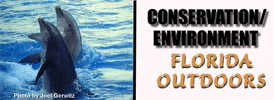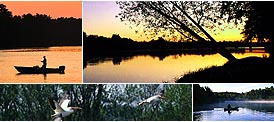
Cypress Swamps | Hardwood Swamps | Freshwater Marshes | Beaches & Dunes | Maritime Forest | Salt Marsh | Mangroves


The Florida Landscape
Florida's landscape, encompassing some 58,664 square miles of land, ranges from the famous, sub-tropical Everglades in the south to the quiet and lesser known temperate hardwood forests and slow moving rivers of the Panhandle. In between are pine flatwoods, cypress and hardwood swamps, agricultural land, urban areas, over thirteen hundred miles of coastline, thousands of lakes, and hundreds of miles of rivers.
The state is unofficially divided into two regions. The smaller Panhandle portion is part of main landmass that makes up the United States. It is like many other parts of the south in terms of its climate, vegetation, and wildlife.
The Gulf of Mexico and Atlantic Ocean heavily influence the larger peninsula portion of Florida. There is no place in the state where you are more than 50 miles from one of these bodies of salt water. The moderating influences of these two oceans has a noticeable effect on the climate and the plants and animals inhabiting the peninsula.
Topography
Florida is, in a word, flat. The state has no mountains. In fact, the highest elevation, 345', occurs just a few miles from the border with Alabama.
With an average height of 100', Florida hills pale in comparison to most other states. The hills that do exist are limited to the panhandle and along the state's central ridge. As you approach the coast elevations drop to the point that many locations five miles from either the Atlantic Ocean or Gulf of Mexico are only 10-15' above sea level.
Most of Florida south of Lake Okeechobee was originally so low the land was too wet to support development. As people discovered the advantage to living in a warm climate, much of this land was made habitable thanks to an extensive series of drainage canals that dried the land enough to permit the cities of Miami, Ft. Lauderdale and surrounding communities to develop. The region is now plagued with the potential for disaster should a major hurricane and the accompanying storm surge hit. The flooding associated with the storm surge threatens thousands of homes.
Climate
The trademarks of Florida's climate, especially in central and south Florida, are humidity and generally warm temperatures. In these areas it is more appropriate to think of the area as having only two seasons: a wet and warm season lasting from June through October followed by a cool and dry season lasting from November through May. In north Florida and the Panhandle, you will experience the traditional spring, summer, fall, and winter seasons typical of a more temperate climate.
The beginning of the warmer, rainy season comes in June. The typical pattern is for daily, primarily afternoon, rains with temperatures ranging from the mid 70s for a low to the upper 90s for a high. Rain comes from thunderstorms that build up in the central part of the state and then move towards the coasts in the late afternoons. Frequent lightning and heavy downpours are common features of these rainmaking events.
This is also the season for tropical storms and hurricanes which have the potential to significantly add to the annual rainfall total in any part of the state. The damaging winds, flooding, and storm surges associated with tropical events make hurricane season a time for all residents to keep a close eye on the weather and any developing systems.
The beginning of the cool and dry season means an end to the daily rains and tropical storm season. It is also the time of year when cold fronts have enough push to move down from the northwest and pass over the peninsula. Generally, temperatures below freezing, common in the panhandle and north Florida, are seldom recorded in central and south Florida. When such freeze occurs, the results are devastating to many plants, the citrus industry and vegetable farmers.
Habitats
Although Florida is a relatively flat state, changes in elevation, sometimes as little as one foot of change, result in major changes in the types of plants and animals that can live in an area. Here is a listing and brief description of the state’s major upland and wetland habitats.












